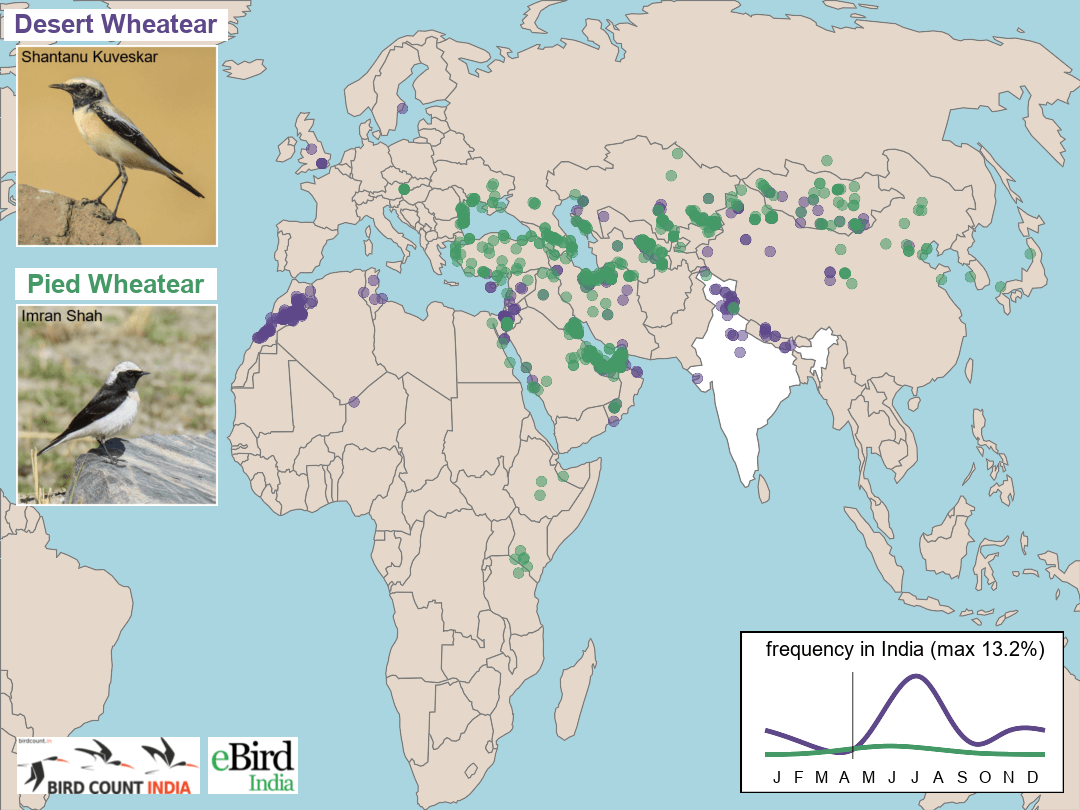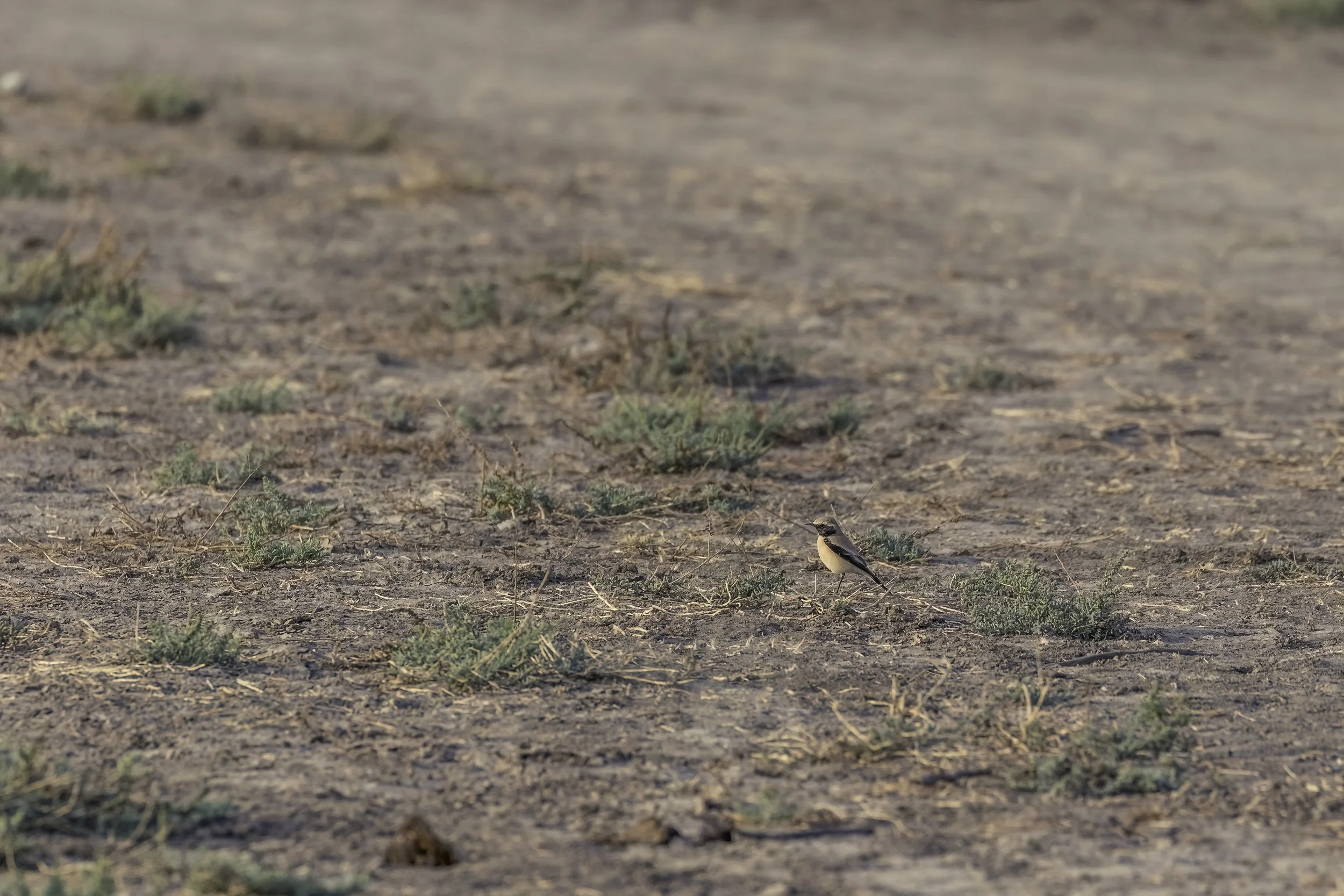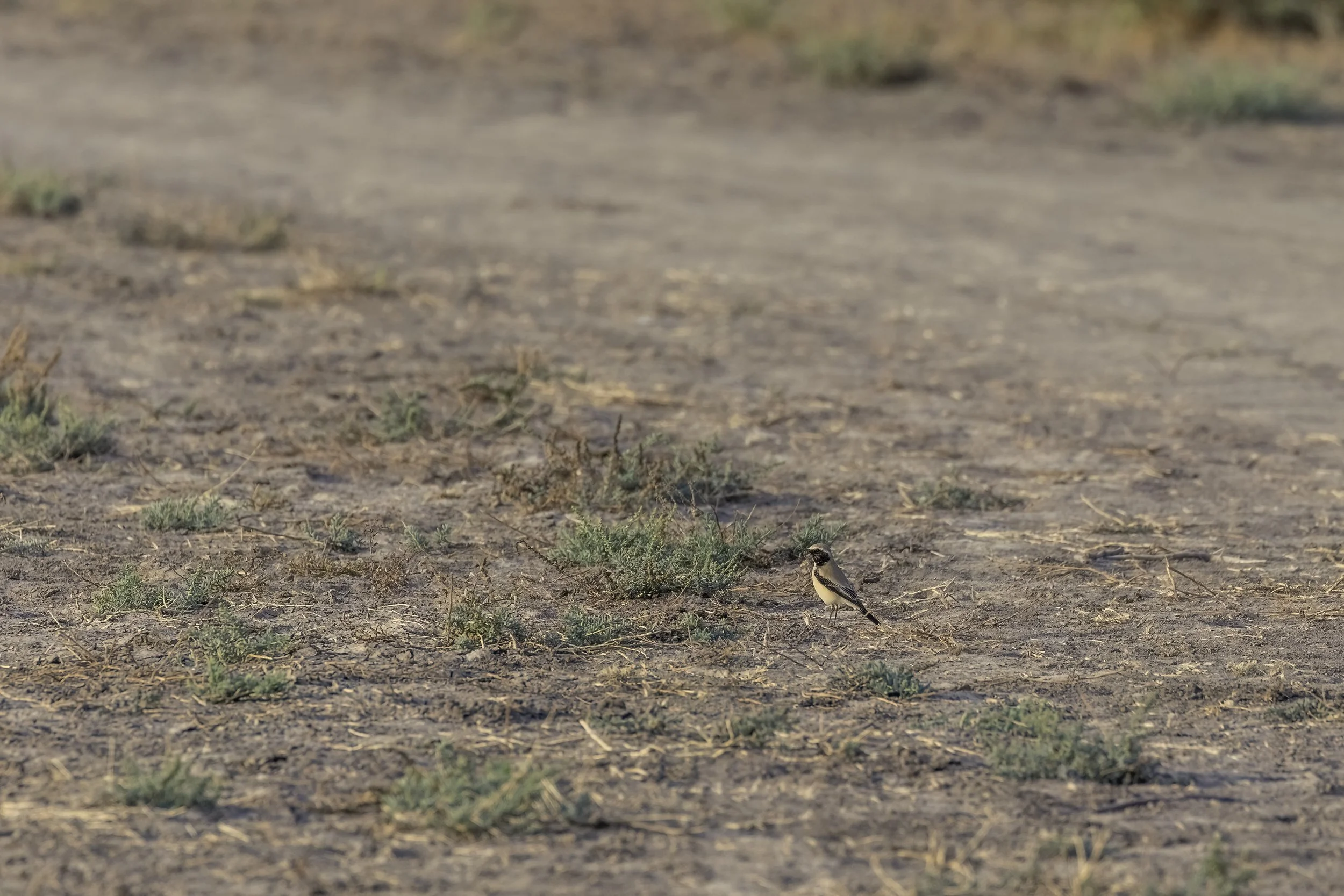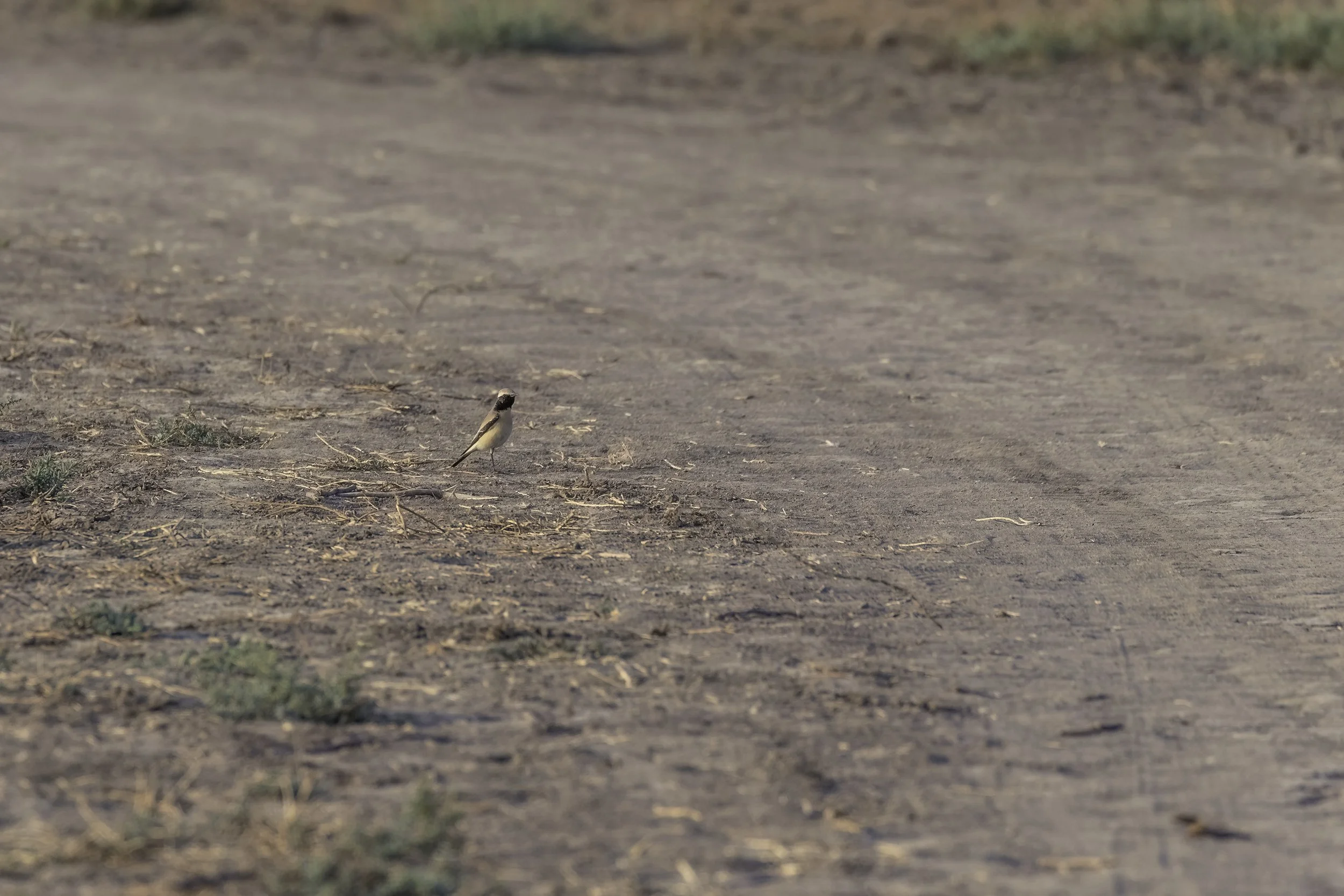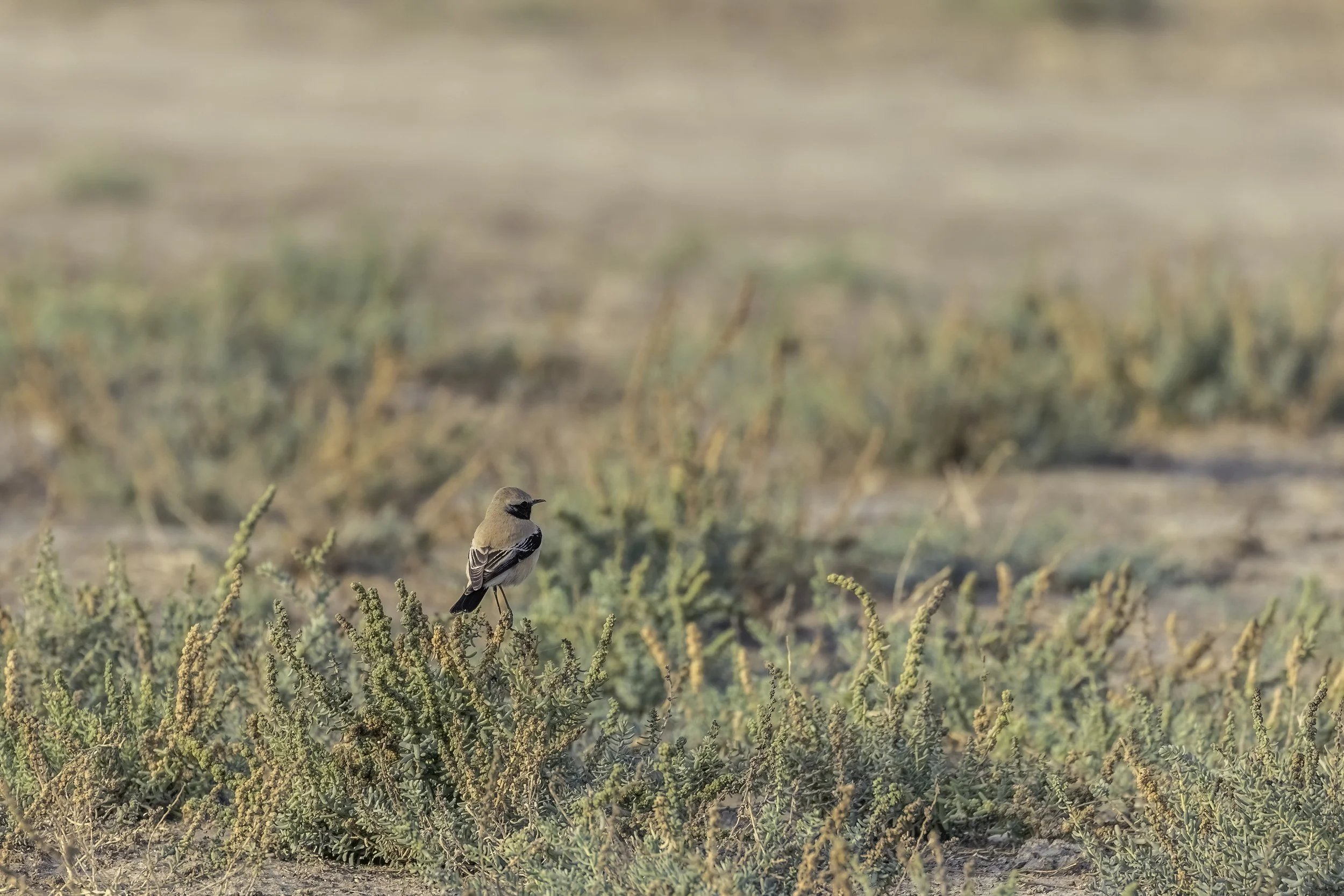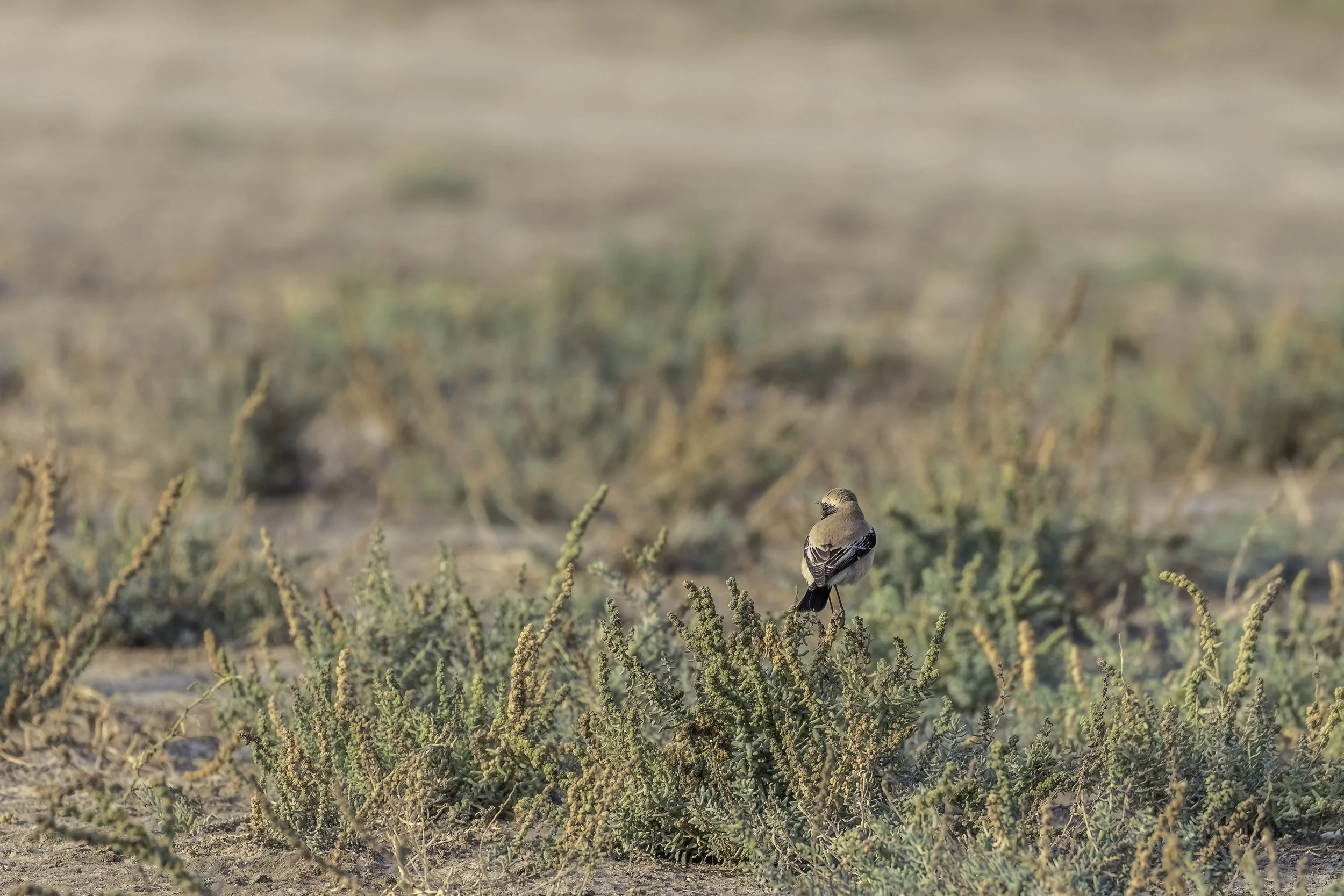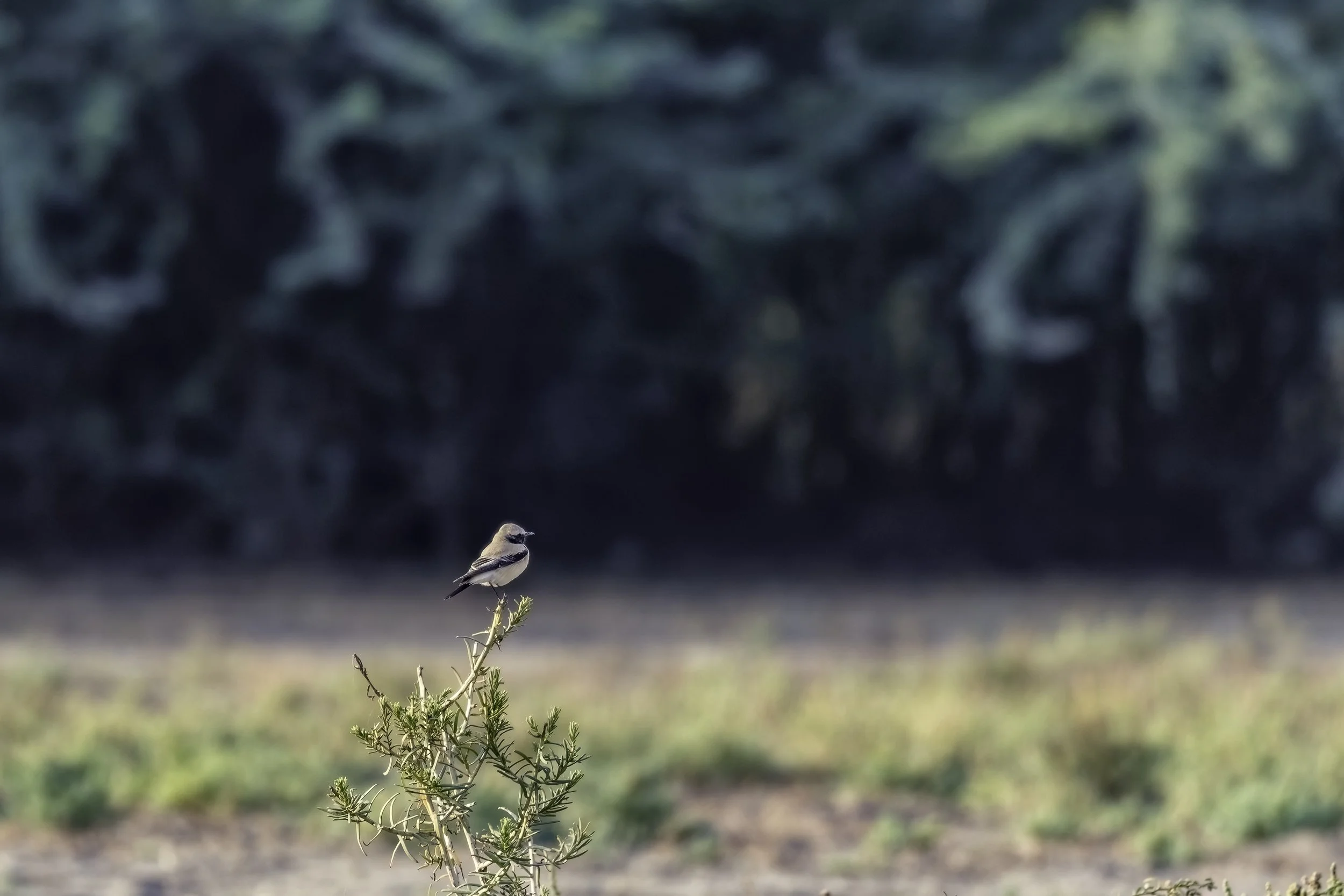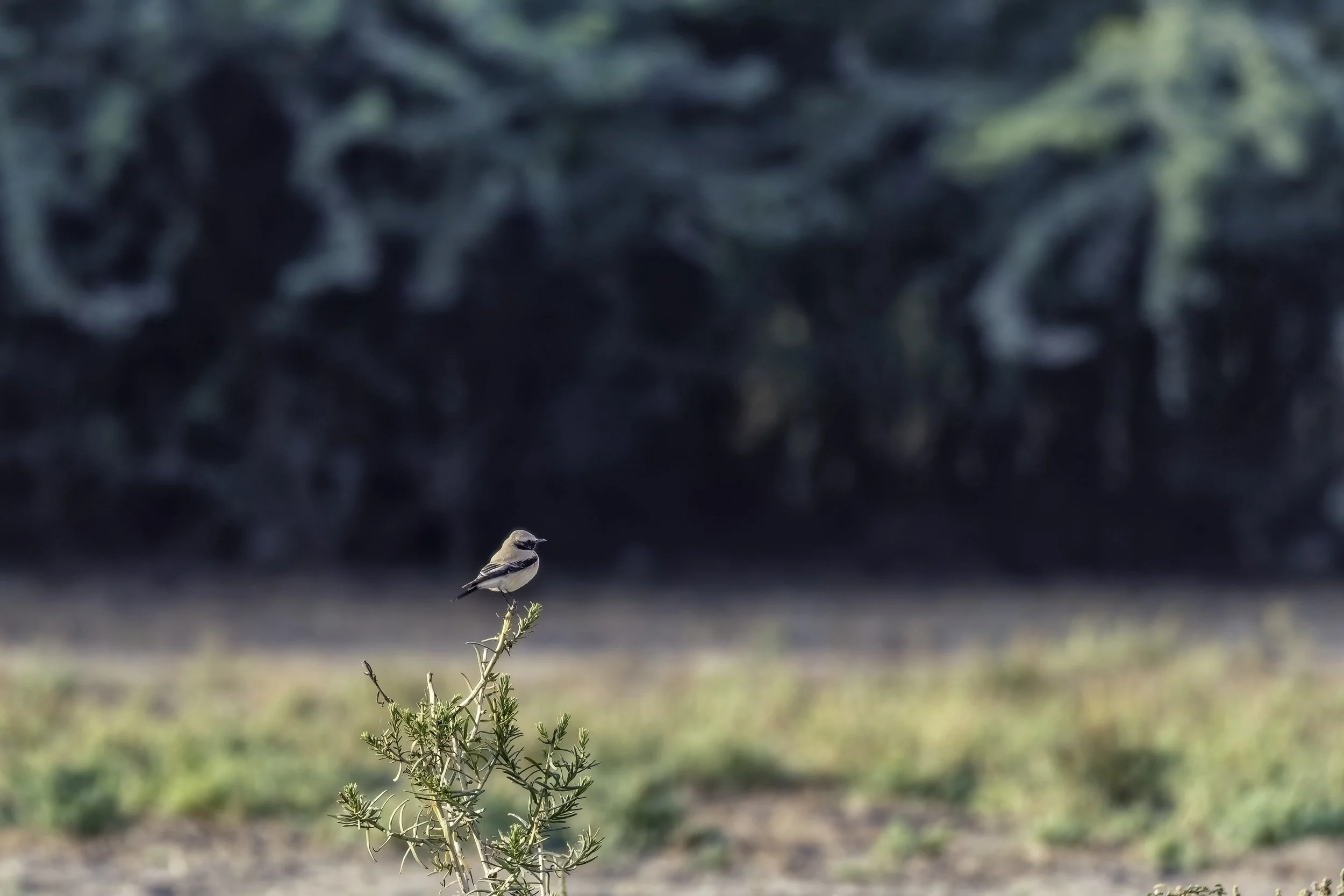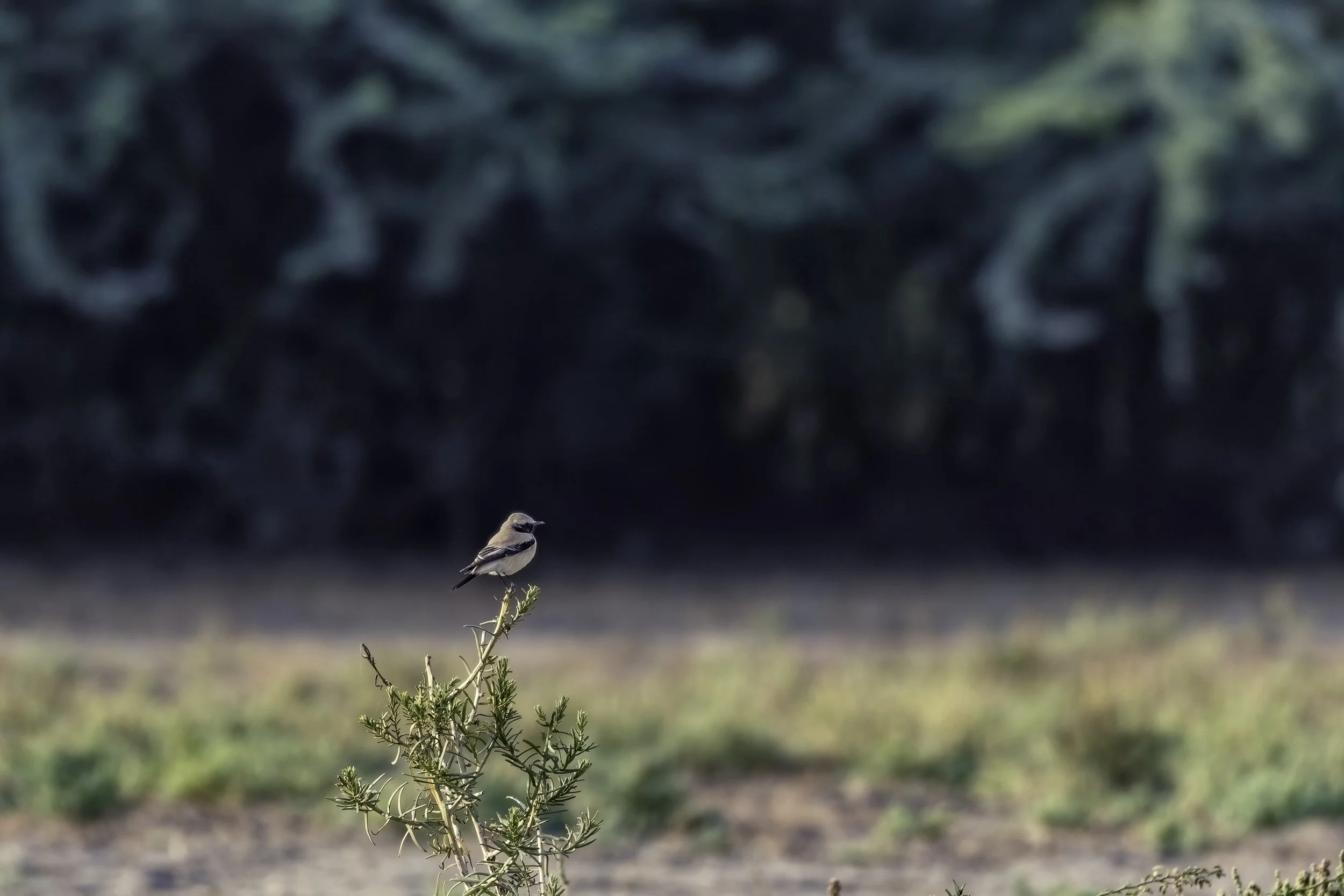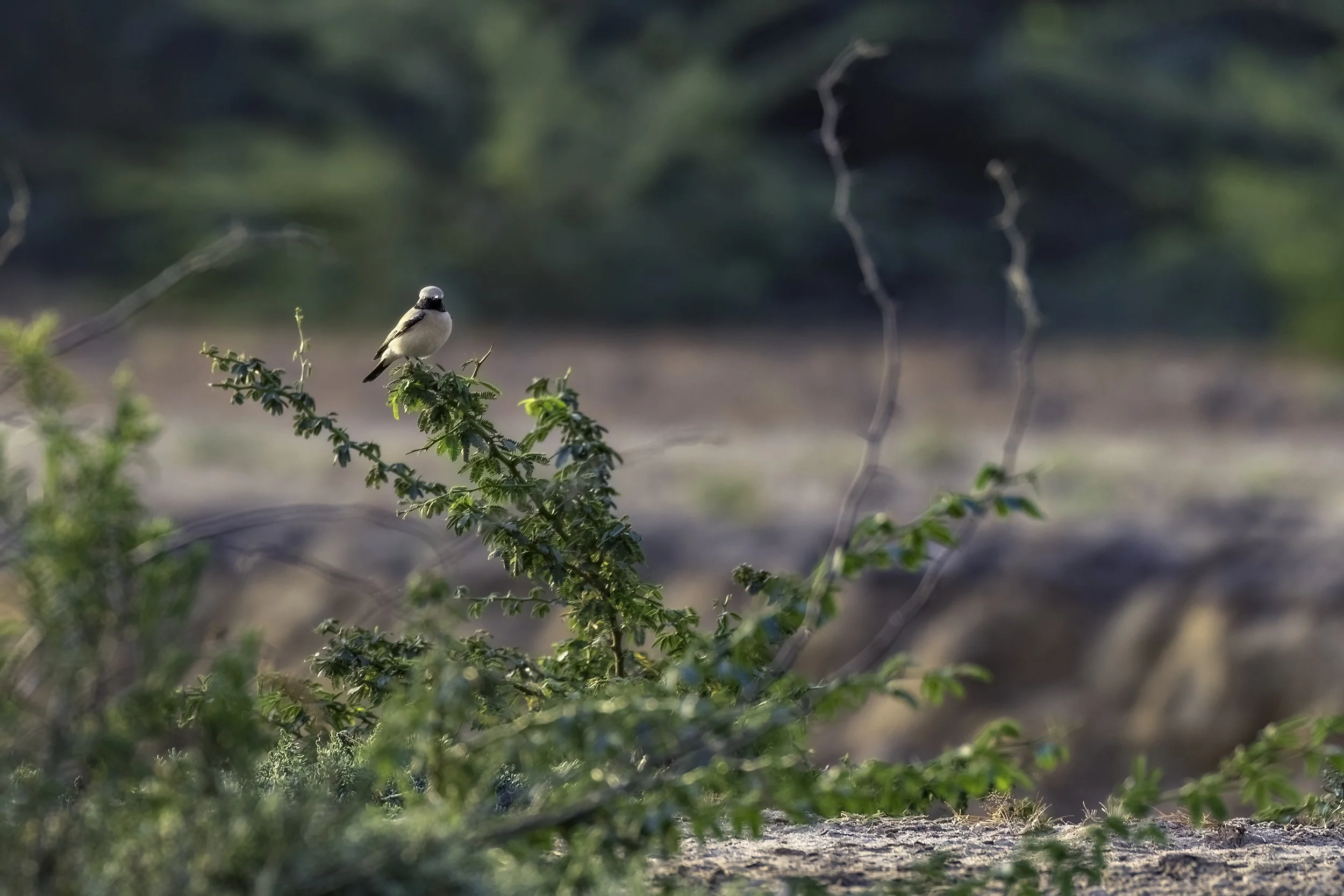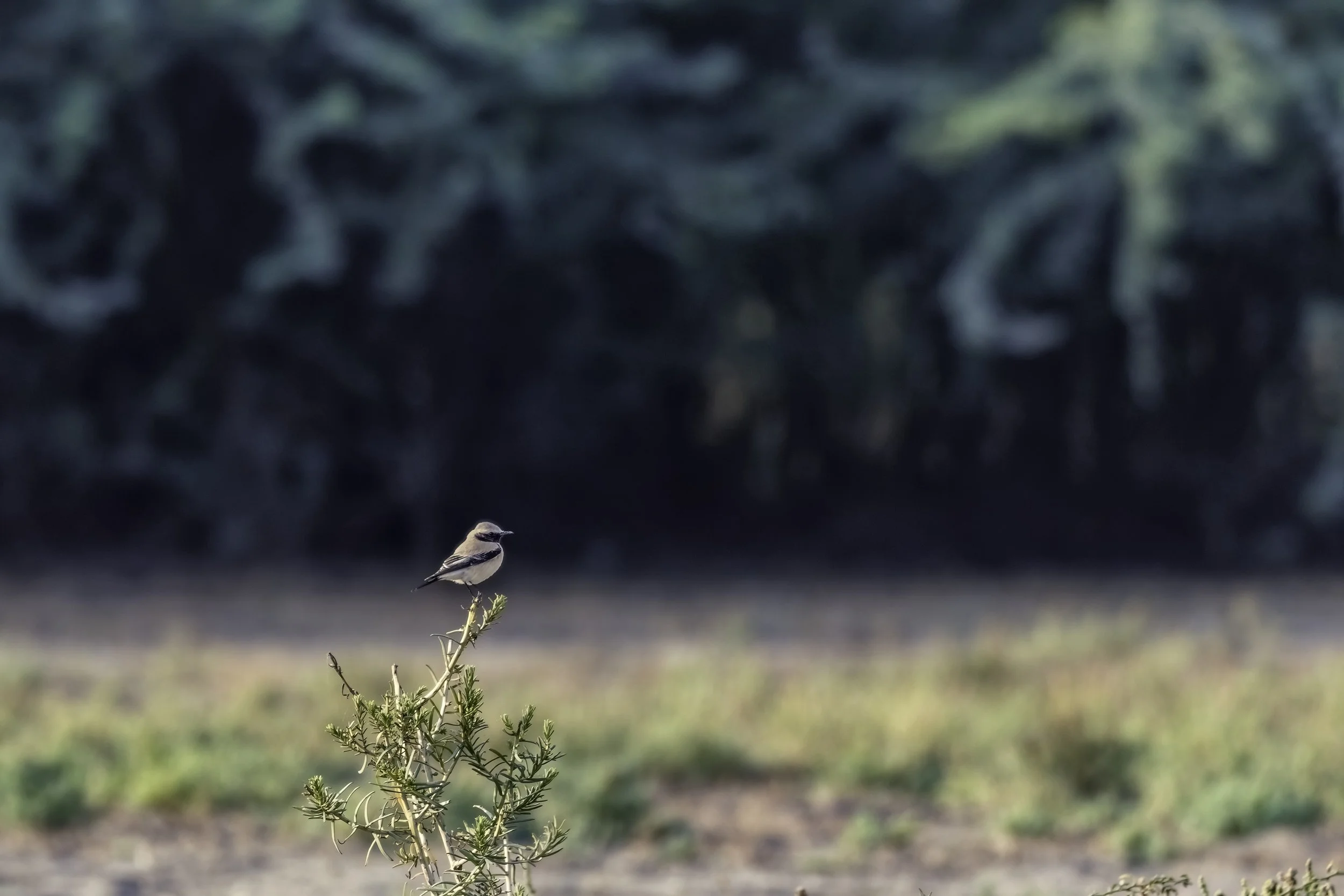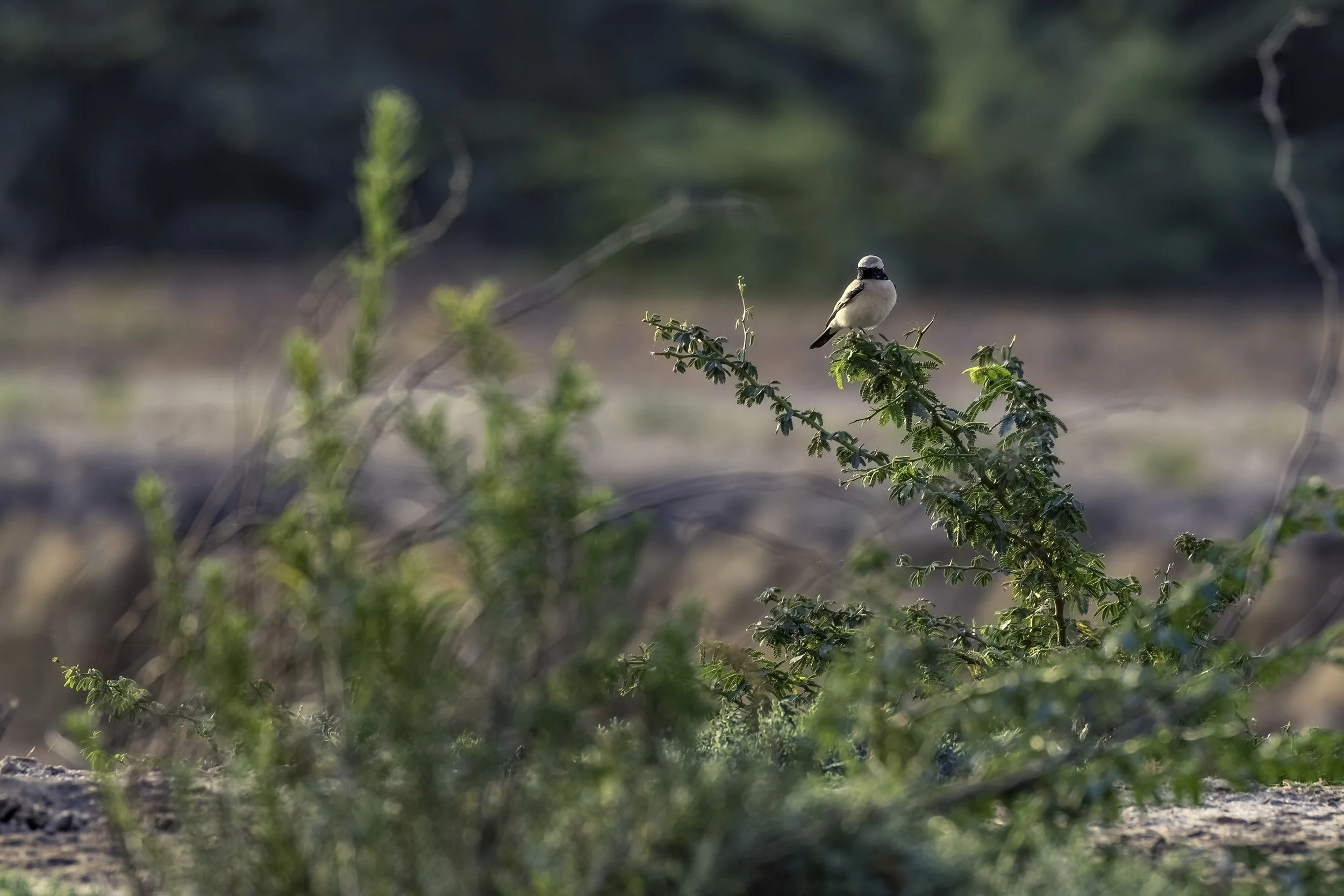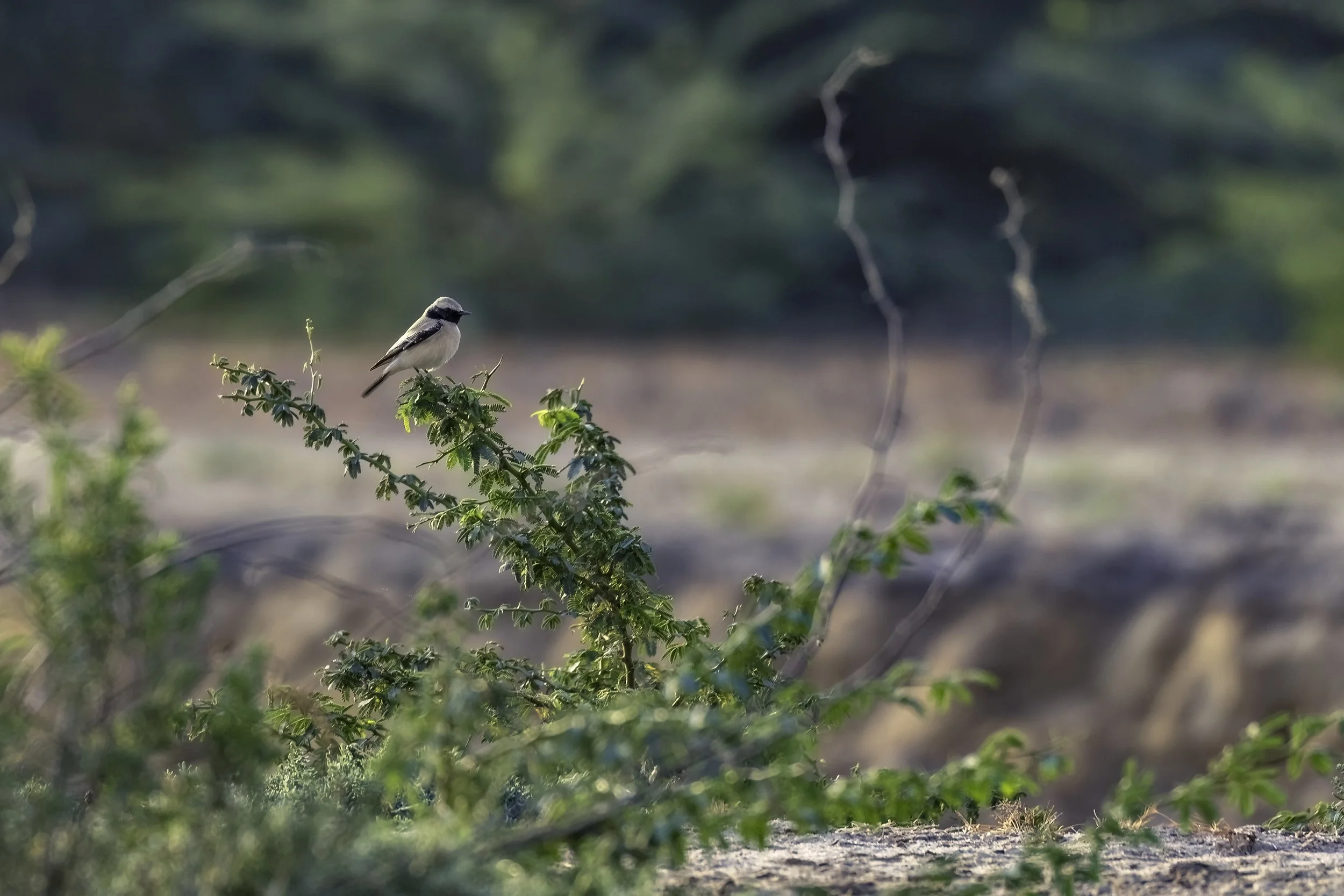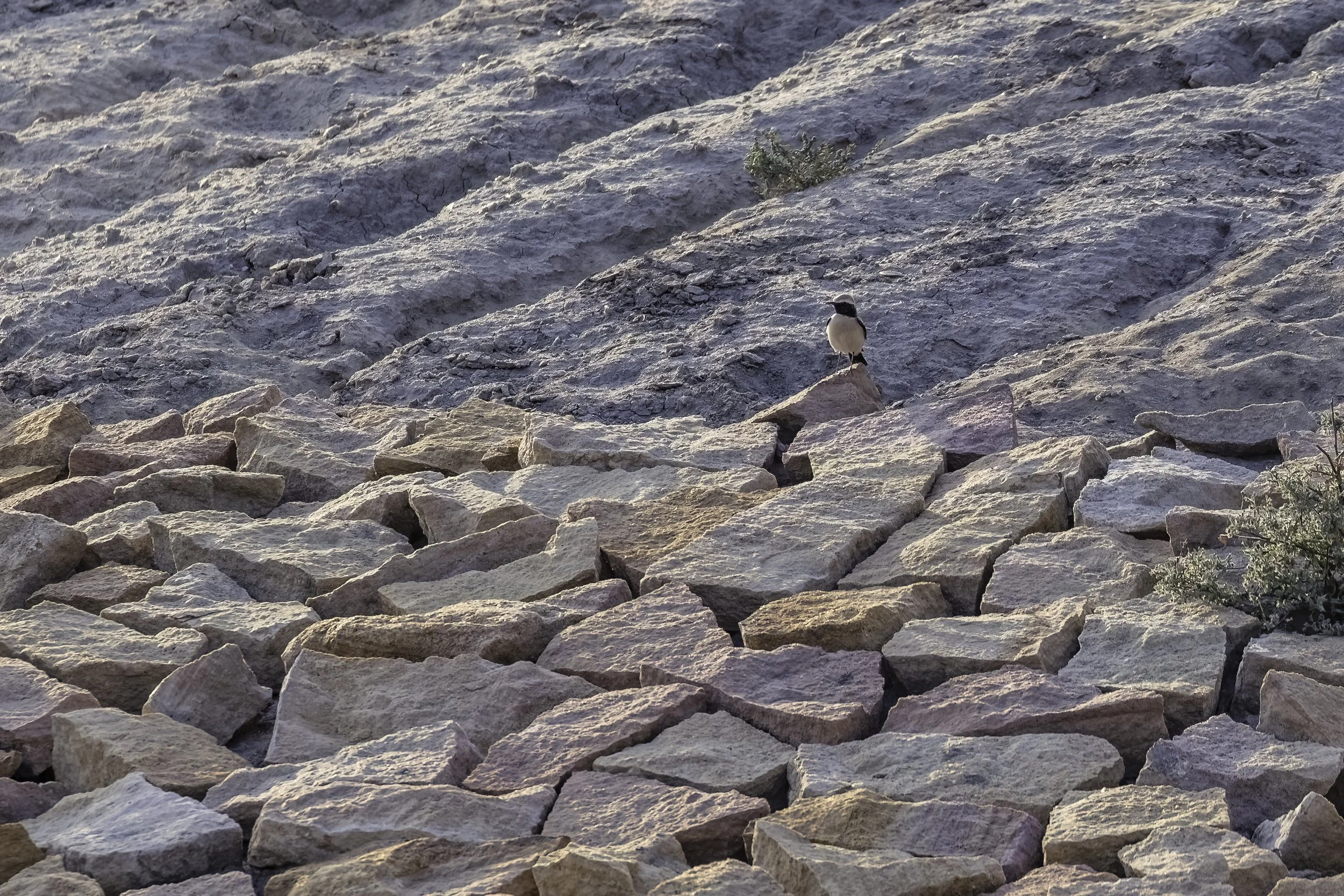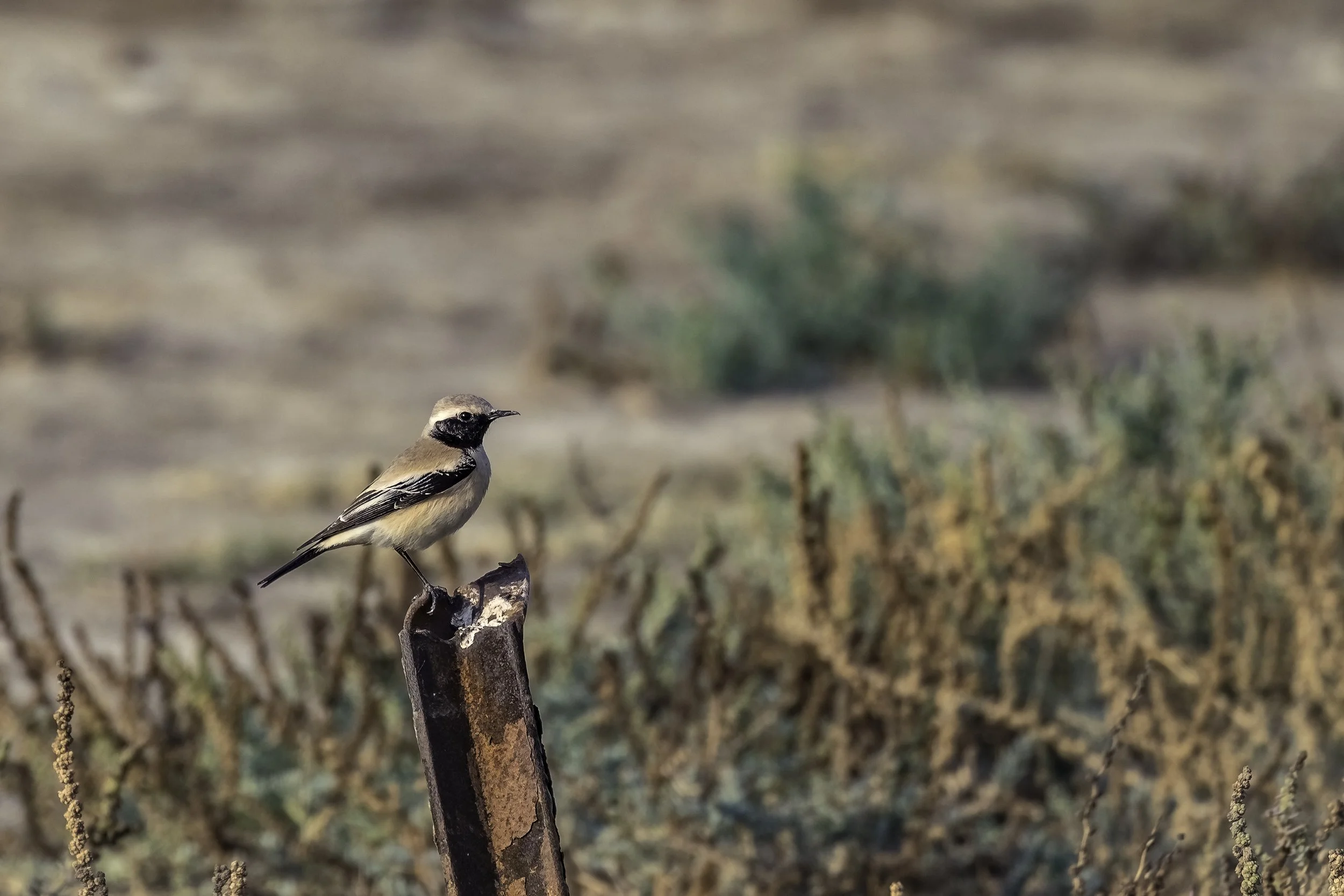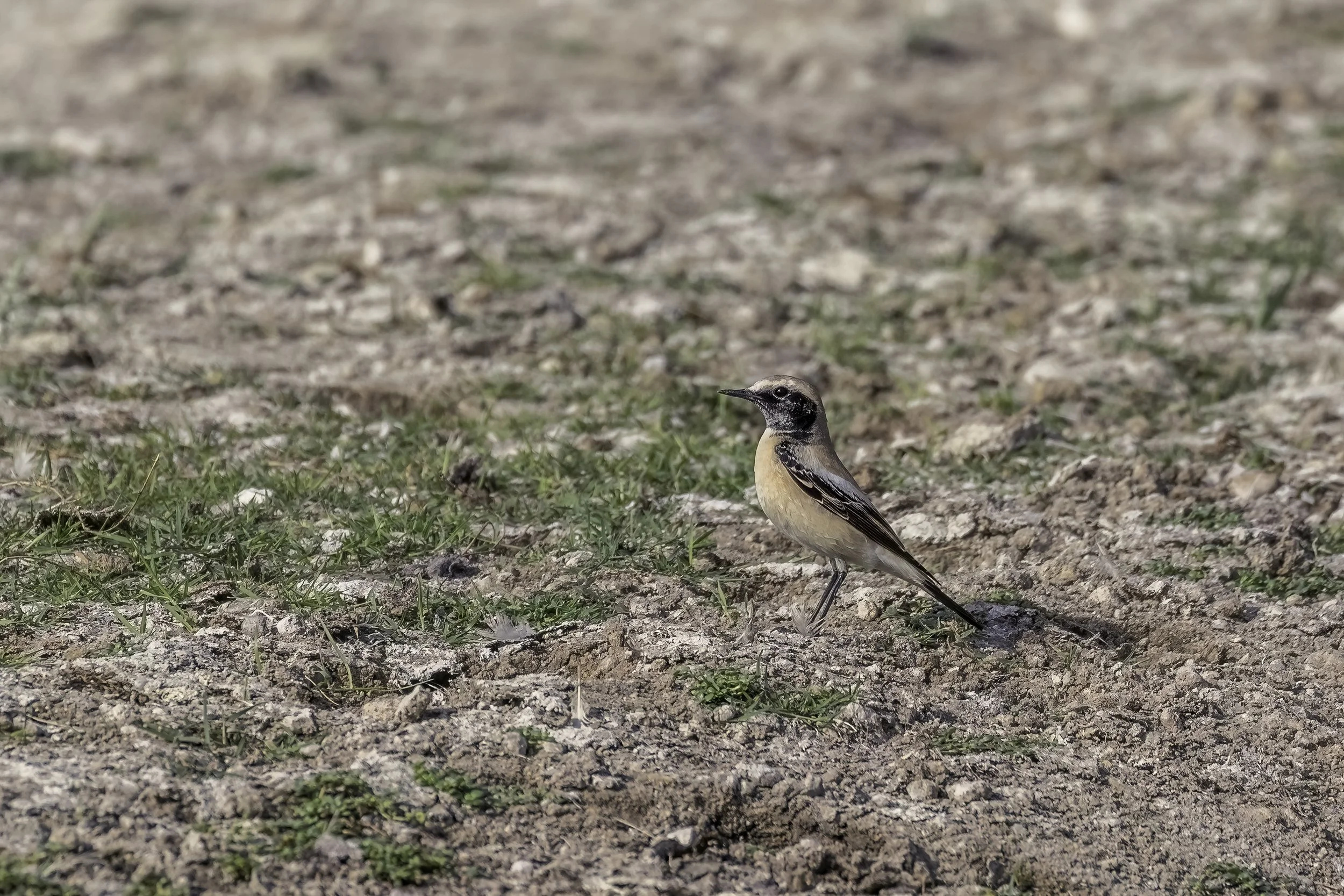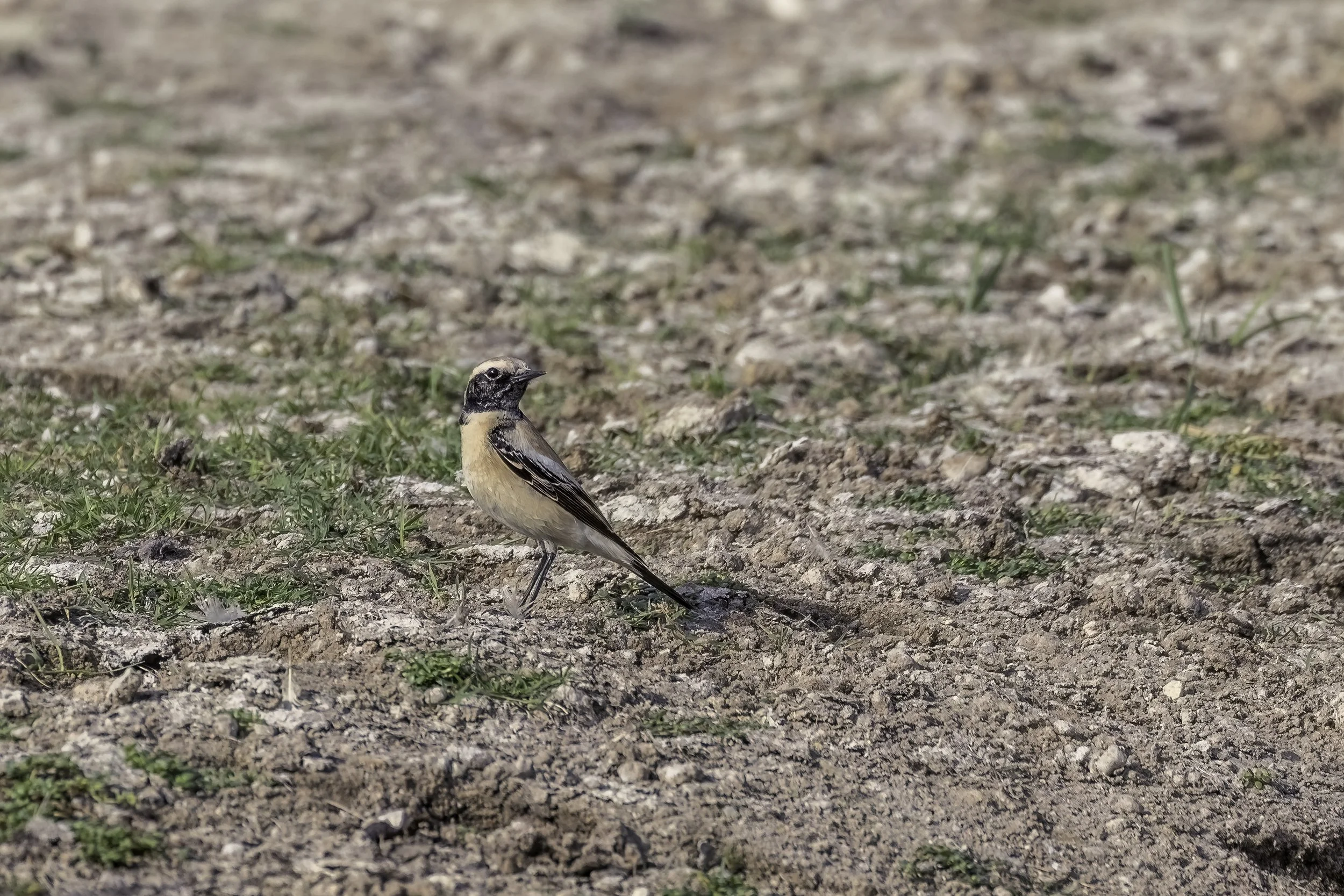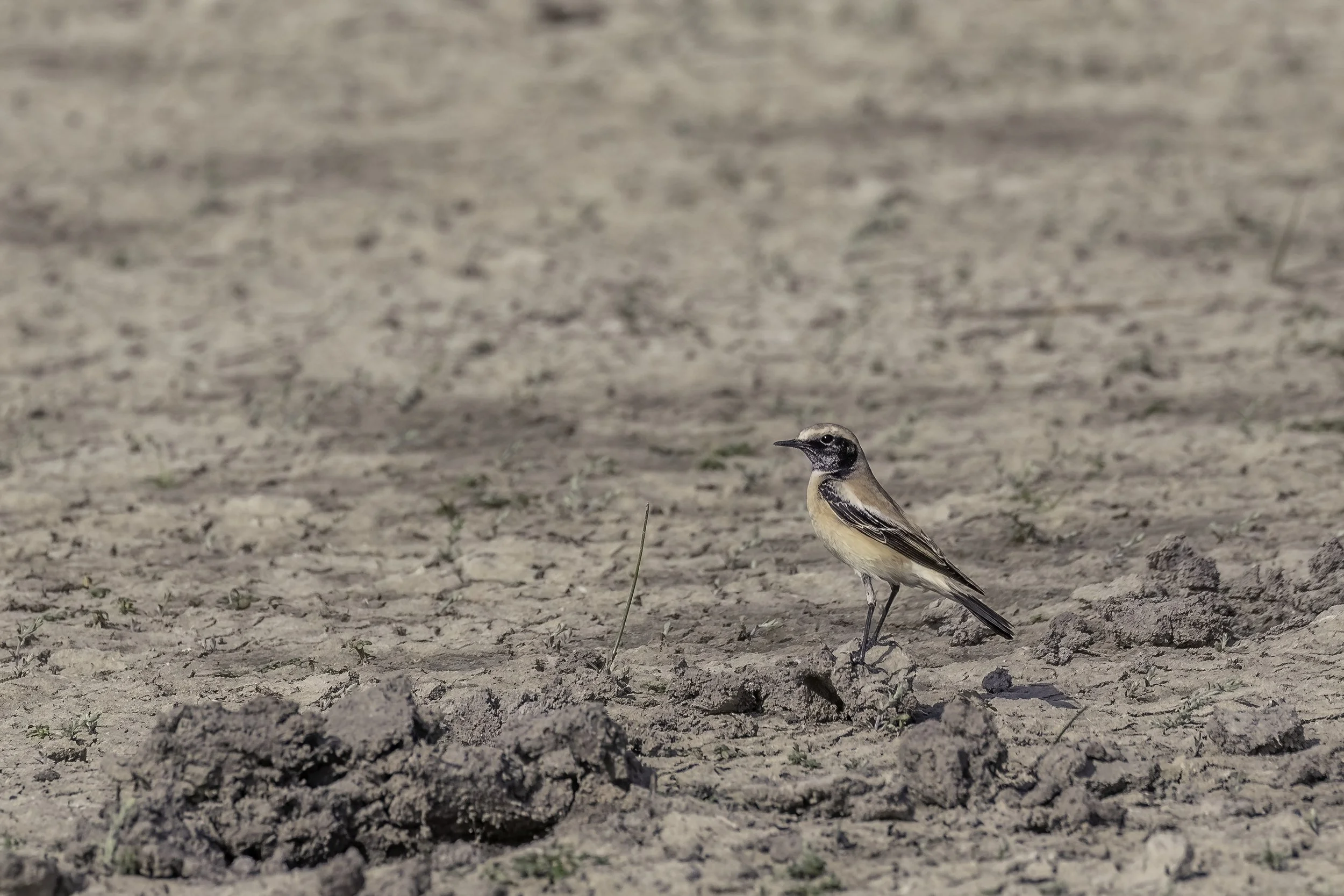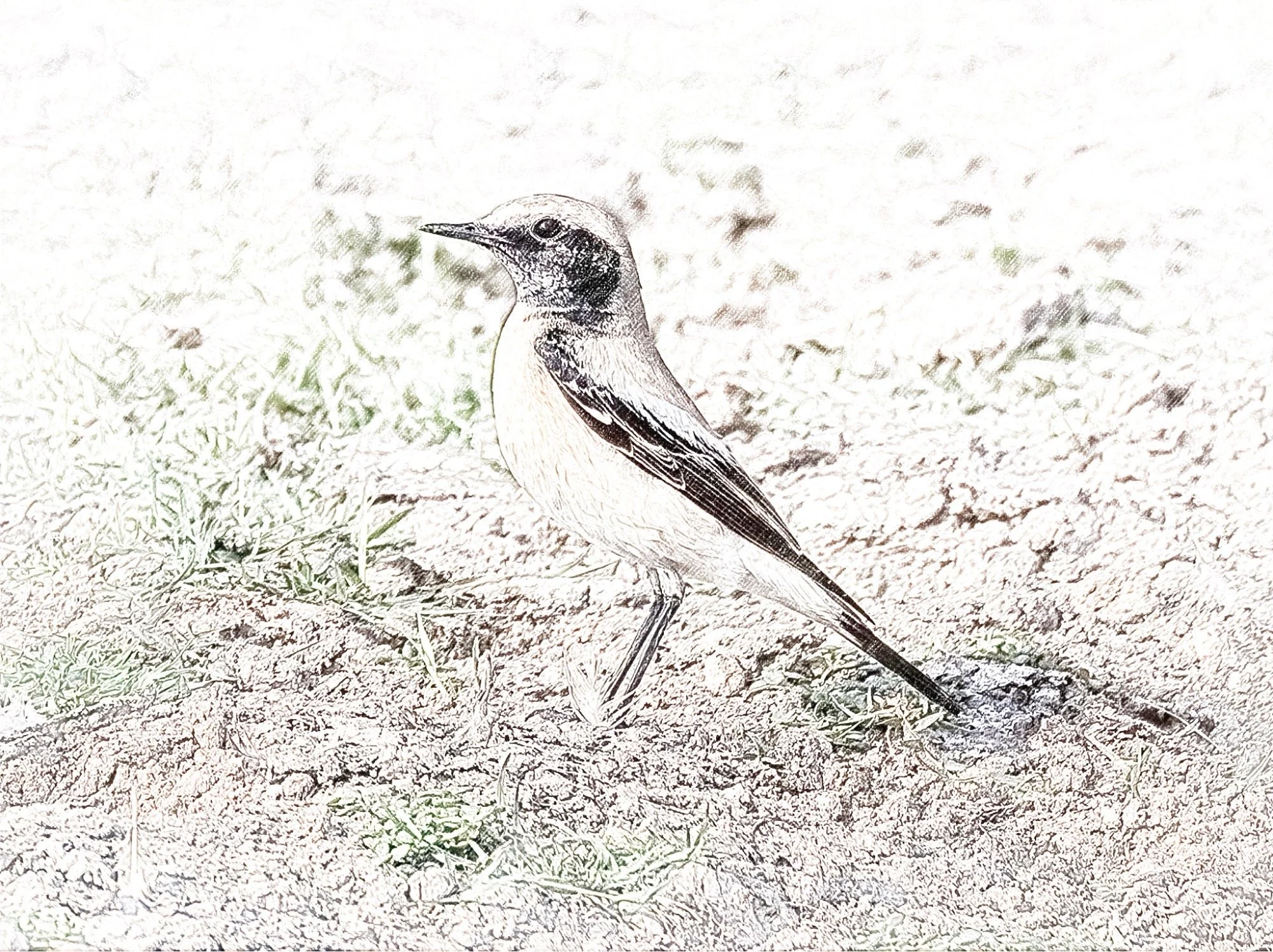Desert Wheatear
Oenanthe deserti
Little Rann of Kutch
As winter approaches I am drawn more and more to the winter migrants that make the diverse habitats of India their home. The Desert Wheatear is one such migratory winter visitor to the Little Rann of Kutch, a salt marsh in Gujarat, India, where its sandy plumage helps it blend in with the arid, open landscape. This small insectivorous bird arrives from its breeding grounds to forage for insects on the ground or on low shrubs in this protected, semi-barren habitat.
The Desert Wheatear breeds in parts of North Africa, the Arabian peninsula, Central Asia and throughout the Tibetan Plateau (Including Ladakh) and the arid habitats in northern and western India form an important part of their winter range. They are frequently seen perched up on posts, telephone lines, and rock mounds. The breeding male is a soft brown above and pale below with a tan breast and a jet-black face, wings, and tail while the non-breeding male’s face is mottled instead of solid black.
The Desert Wheatear was formerly classed as a member of the thrush family Turdidae, but is now more generally considered to be an Old World Flycatcher (Muscicapidae). It is a migratory insectivorous species measuring between 14.5 to 15 cm in length.
The Rann of Kutch (alternately spelled as Kuchchh) is a large area of salt marshes that spans the border between India and Pakistan. It is located mostly in the Kutch district of the Indian state of Gujarat, with a minor portion extending into the Sindh province of Pakistan. It is divided into the Great Rann and Little Rann.
The Rann of Kutch covers around 26,000 km² (10,000 square miles). The Great Rann of Kutch is the larger portion of the Rann and it extends east and west, with the Thar Desert to the north and the low hills of Kutch to the south. The Indus River Delta lies to the west in southern Pakistan. The Little Rann of Kutch lies southeast of the Great Rann, and extends southwards to the Gulf of Kutch. Many rivers originating in Rajasthan and Gujarat flow into the Rann of Kutch, including the Luni, Bhuki, Bharud, Nara, Kharod, Banas, Saraswati, Rupen, Bambhan, and Machchhu. Kori Creek and Sir Creek, tidal creeks which are part of the Indus River Delta, are located at the western end of the Great Rann.
The surface is generally flat and very close to sea level, and most of the Rann floods annually during the monsoon season. There are areas of sandy higher ground, known as bets or medaks, which lie two to three metres above flood level. Read more about the Khadir Bet island where I talk about Dholavira later. Trees and shrubs grow on the bets, and they provide refuges for wildlife during the annual floods. The climate of the ecoregion is subtropical. Temperatures average 44°C during the hot summer months, and can reach highs of 50°C and during the winter the temperature can drop to or below freezing.
Rainfall is highly seasonal with the Rann being dry for most of the year, and rainfall is concentrated in the June to September monsoon season. During the monsoon season, local rainfall and river runoff flood much of the Rann to a depth of 0.5 metres. The waters evaporate during the long dry season, leaving the Rann dry again by the start of the next monsoon season.
The Rann of Kutch is the only large flooded grasslands zone in the Indomalayan realm. The area has desert on one side and the sea on the other enables various ecosystems, including mangroves and desert vegetation. Its grassland and deserts are home to forms of wildlife that have adapted to its often harsh conditions. These include endemic and Endangered animal and plant species. The predominant vegetation in the Rann of Kutch is grassland and thorn scrub. Common grass species include Apluda aristata, Cenchrus spp., Pennisetum spp., Cymbopogon spp., Eragrostis spp., and Elionurus spp.
Very unique to this Rann, are the shrubs and wetlands, as well as the colonies of flamingos, which make it one of the rarest sites on earth. Established in 1973, under the Wildlife Protection Act, the WildAss Sanctuary protects the Endangered (Schedule - I) and endemic Indian Wild Ass (Equus Hemionus Khur) popularly known as Khur or Ghudkhur. Trees are rare except on the bets which rise above the flood zone. The non-native tree Prosopis juliflora has become established on the bets, and its seed pods provide year-round food for the Near Threatened Indian Wild Ass. The Little Rann of Kutch Wildlife Sanctuary is a desolate area in western Gujarat, a refuge for the Endangered Indian Wild Ass and one of the few places where the ass survives in the wild. Interestingly, this animal has its only gene pool in the Little Rann. This biogeographical region is a part of Desert, but is unlike the neighbouring sandy desert in Rajasthan or elsewhere in the world.
Read about the Indian Wild Ass here.
The stark habitat of the Little Rann which plays host to a multitude of birds like the Bar-headed Geese - a goose that breeds around lakes and marshes on the highland plateaus of Central Asia and winters in the lowland wetlands and fields of Central and South India. They are one of the world's highest-flying birds, having been heard flying across Mount Makalu – the fifth highest mountain on earth at 8,481 m (27,825 ft)
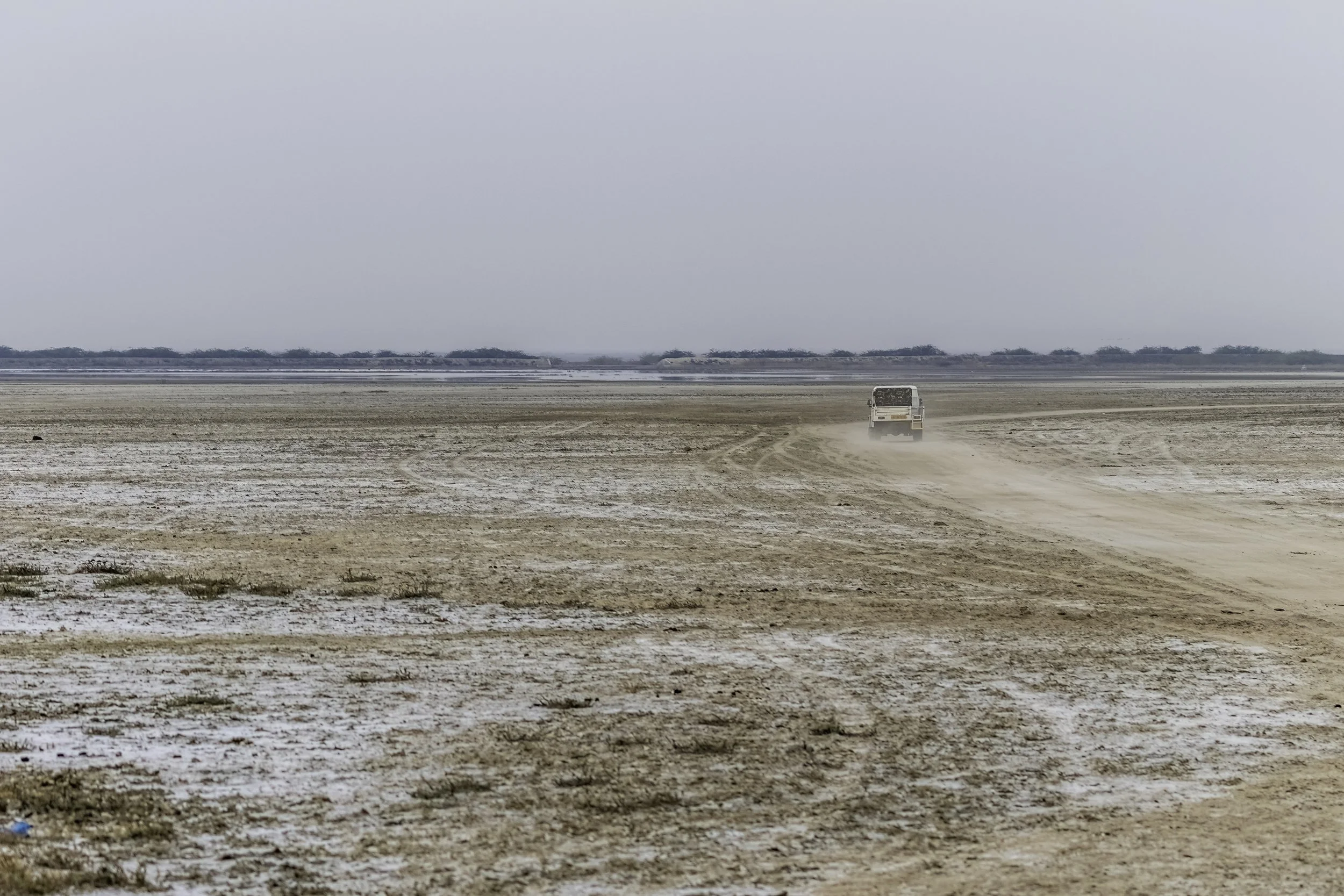
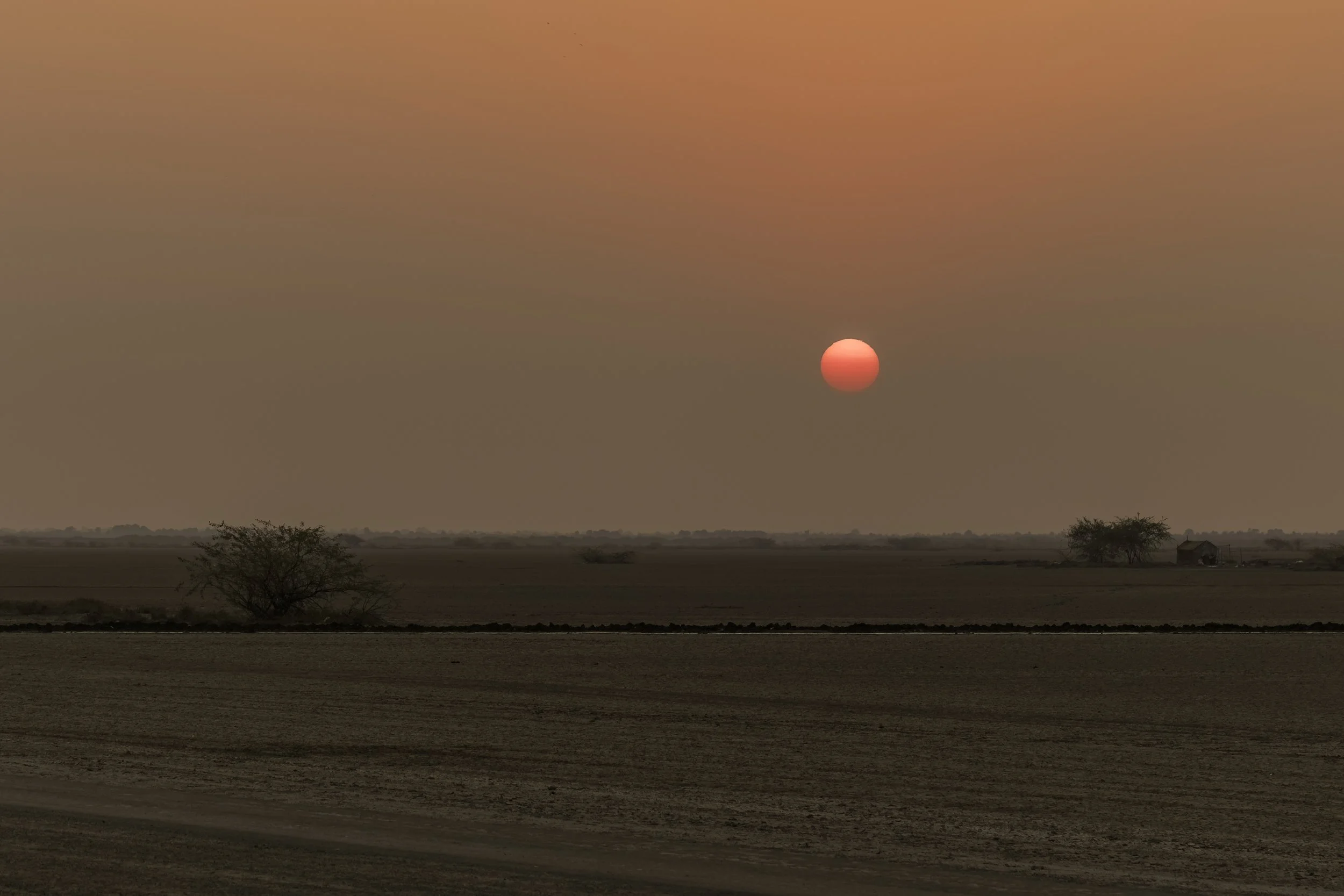
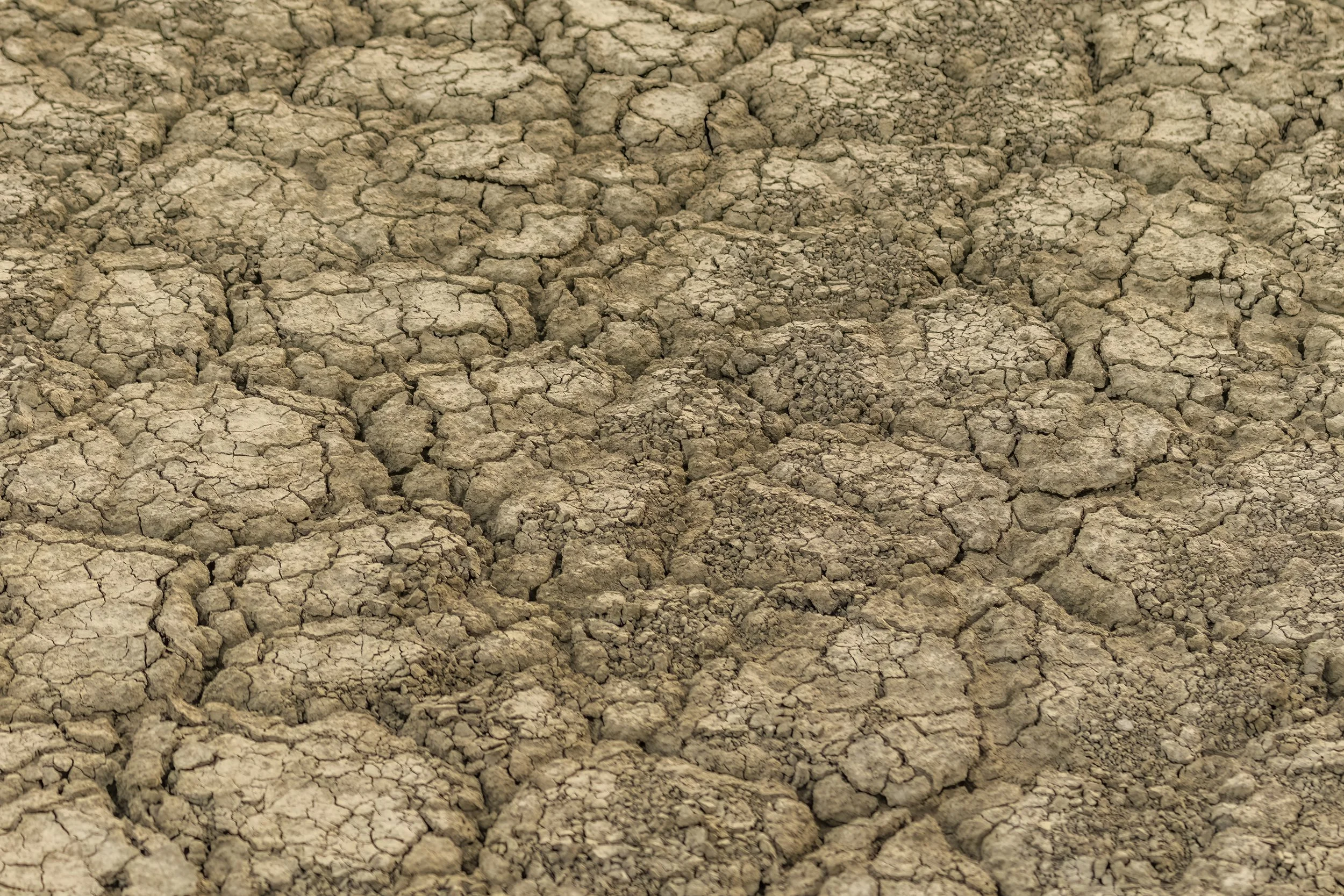
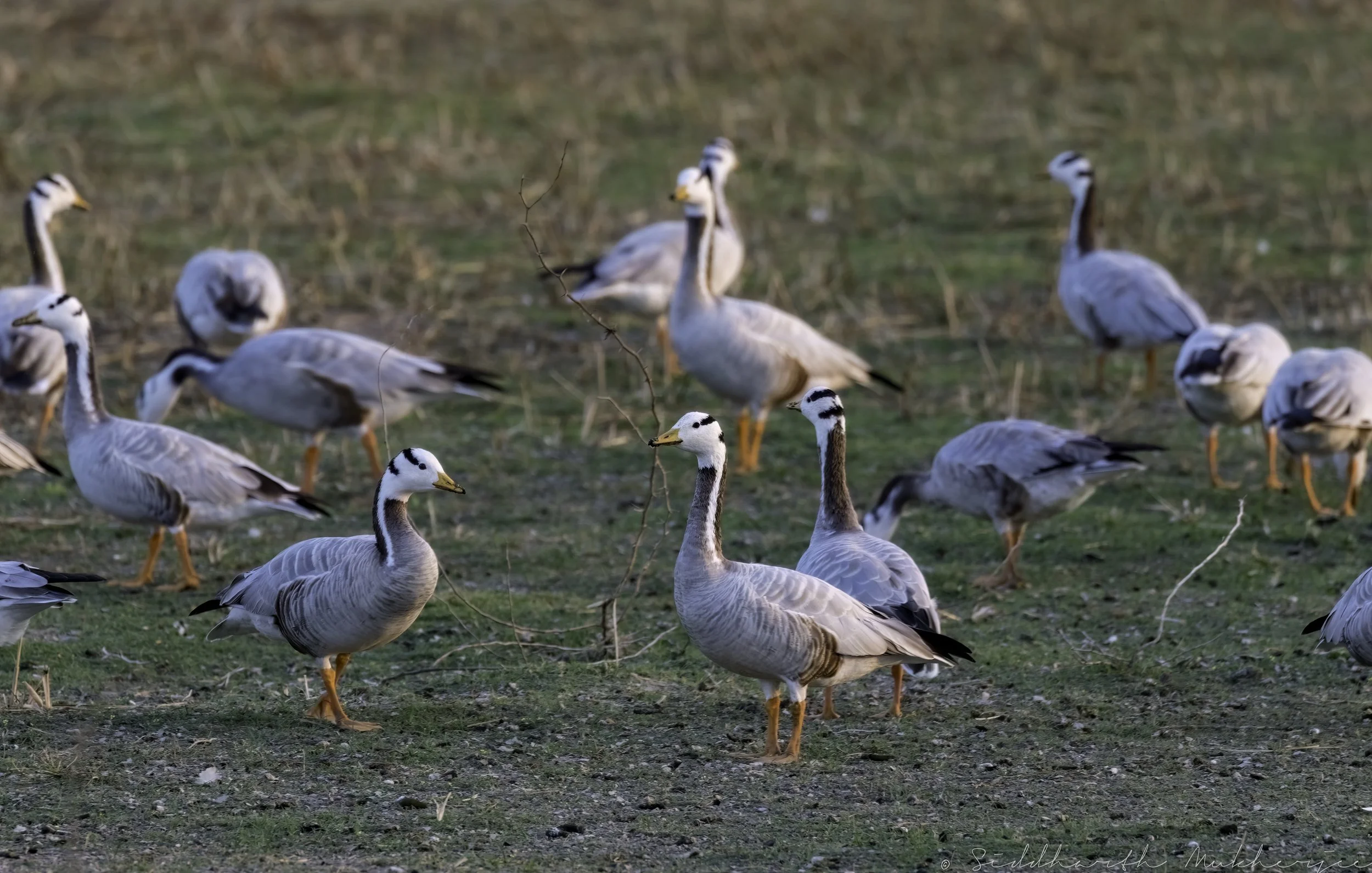
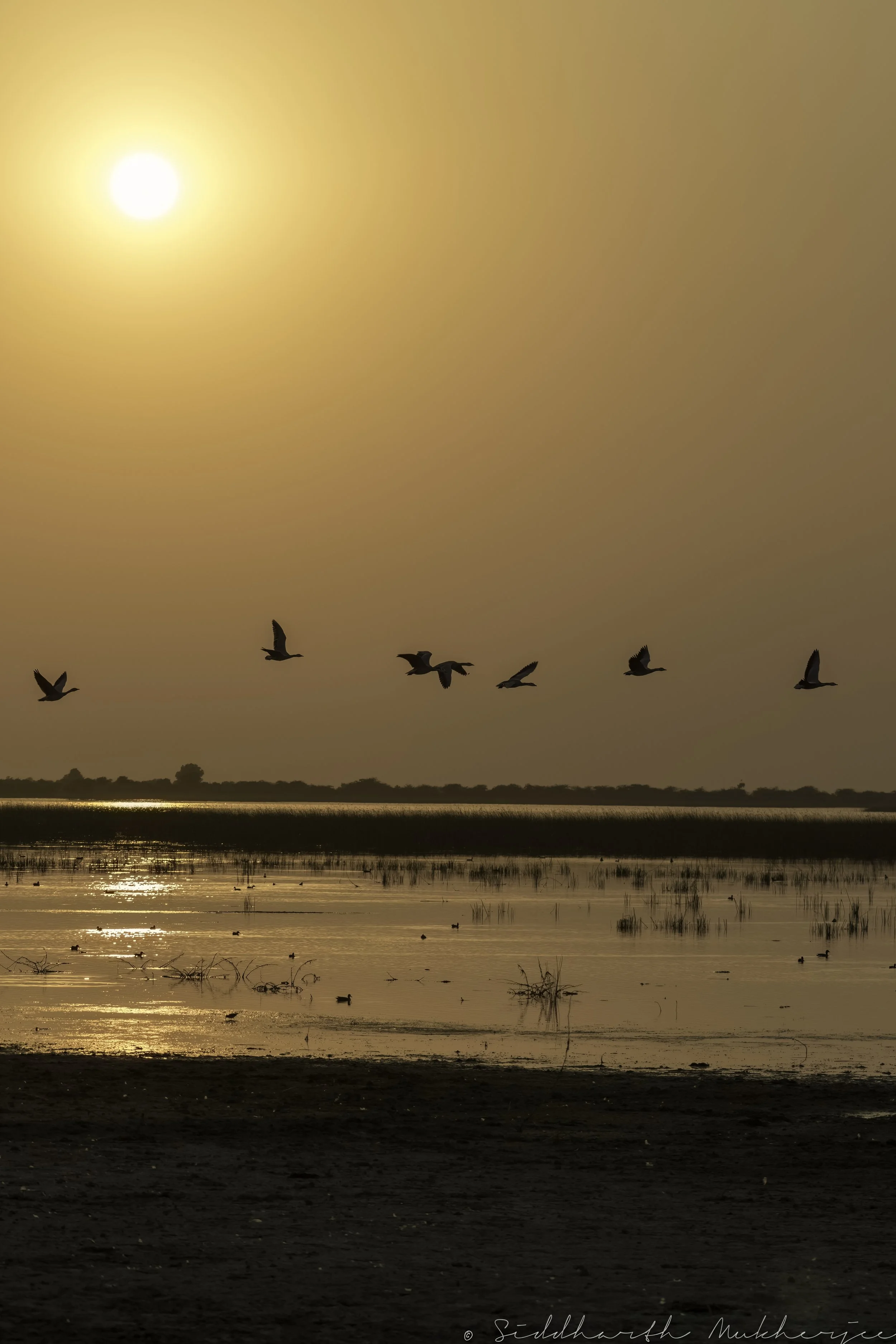
Birds found in the Little Rann include the Steppe, Imperial, and short-toed eagles, Houbara bustard, flamingos, pelicans, storks and cranes like the Demoiselle Crane. You can expect to see large flocks of larks and other dry-land birds such as sand grouse, coursers, plovers, chats, warblers, babblers and shrikes. The best birding is in the winter months from October to March, when quantities of waterfowl gather. This is the time when demoiselle and common cranes, and lesser flamingoes are seen in incredibly large numbers. The wetlands also attract large numbers of waterfowl. During the monsoon when the park is closed, the salt pans flood, and at other times of the year a thin, hard surface layer hides treacherous quicksand.
Covering a staggering 4,950 square kilometres, the Little Rann of Kutch it is one of India’s largest reserves, with a diverse landscape – an impressive mixture of arid, and treacherous, salt flats, desert grassland, scrubland, lakes and marshes. It is home to numerous species of mammals like the Indian Wild Ass, the Nilgai, Indian Wolf, Indian Fox, Desert Fox, Jackal, Striped Hyena, Wild Boar, Jungle Cat as well as Chinkara and Blackbuck.
The surrounding areas include Lake Nawa Talao, the village lake of Dasada, the wetlands near Patdi Fort, Viramgam Lake and Surendranagar reservoirs – all of which offer great winter birding opportunities with regular sightings of rose-coloured starlings, green pigeons and Critically Endangered Lesser Florican. Slightly further afield is the Nalsarovar Bird Sanctuary and the famed Sun Temple of Modhera.
Nalsarovar Bird Sanctuary lies 44 kilometres from Dasada and the Little Rann of Kutch National Park. This 105 km² sanctuary comprises a large lake & its surroundings, and is renowned as one of the finest birding sites in West India. As well as the extensive variety of birds seen in large flocks at the lake, and their predators such as marsh harrier and fishing eagle, you can also see numerous passerines in the neighbouring bushes, grasslands and fields. Sarus cranes are also frequently sighted.
The 11th century Sun Temple at Modhera is one of the finest shrines in West India. It was constructed by the Solanki Rajput kings, using the donations of devotees who practiced the ancient tradition of sun worship. The magnificent temple features amazingly detailed carved arches and pillars that rival the temples of Konark and Khajuraho. More about the stunning Modhera Sun Temple later and in the meantime if it piques the interest you can read about the mind boggling Konark Temple here.
The Little Rann of Kutch is located around 100 kilometres north of Ahmedabad on an ancient trading route dating back to early neolithic settlements. It was later inhabited by the Indus Valley civilisation as well as the Maurya and Gupta empires of India. I have written about one of the mega cities from the times of the Indus Valley Civilisation, known locally as Kotada timba - Dholavira. The people of the Indus civilization appear to have settled in the Rann of Kutch around 3500 BCE. The Indus city of Dholavira, the largest Indus site in India, is located here in the Rann of Kutch. Its location is on the Tropic of Cancer and it is one of the five largest Harappan sites and the most prominent site in India possibly indicating that Dholavira's inhabitants were skilled in astronomy.
Many Indologists such as A. S. Gaur and Mani Murali hold the view that the Rann of Kutch was, rather than the salt marsh that it is today, a navigable archipelago at the time of the Indus Civilization. The Indus Civilization was known to have an extensive maritime trade system, so it has been proposed by Gaur et al. that there were perhaps ports in the Rann of Kutch.
Read about the Harappan mega city of Dholavira here.
With that said lets move onto our focus today, the Desert Wheatear.
Desert Wheatear
The Desert Wheatear (Oenanthe deserti) is a wheatear, a small passerine bird that was formerly classed as a member of the thrush family Turdidae, but is now more generally considered to be an Old World Flycatcher (Muscicapidae). It is a migratory insectivorous species ranging between 14.5 to 15 cm in length. Both the western and eastern forms of the Desert Wheatear are rare vagrants to western Europe. The western desert wheatear breeds in the Sahara and the northern Arabian Peninsula. The eastern race is found in the semi-deserts of Central Asia and in winter in Pakistan and northeast Africa.
The Desert Wheatear measures between 14.5–15 cm in length and weighs between 15–34 grams. The plumage of the upper parts of the male in summer is buff. The underparts are white with a buff tinge on the breast. The black on the face and throat extends to the shoulders, and there is distinct white superciliary stripe. The female is greyer above and buffer below and has no black on the throat, and in the winter plumage the black on the throat of the male is partially obscured by the white tips of the feathers. A distinguishing characteristic, in both sexes of all ages, is that the entire tail is black to the level of the upper tail-coverts. The juvenile is like the non-breeding female, but buff-spotted above, finely scaled brownish on breast. The first-winter male is like the breeding female, but with traces of blackish on ear-coverts and neck side. The race homochroa is pinkish-cinnamon, rather than sandy-brown while the race oreophila is larger, with much white on inner webs of flight-feathers.
The genus name Oenanthe is derived from the Ancient Greek oenos (οίνος) "wine" and anthos (ανθός) "flower". It refers to the northern wheatear's return to Greece in the spring just as the grapevines blossom. The specific deserti is Latin for "desert". "Wheatear" is not derived from "wheat" or any sense of "ear", but is a 16th-century linguistic corruption of "white" and "arse", referring to the prominent white rump found in many species.
Several races in center of range are sometimes discriminated (salina and atrogularis) but distinctions are very slight, and better treated as synonyms of the nominate. The boundaries of the races is not well established and the details below are provisional. Three subspecies are recognized.
Oenanthe deserti homochroa: Distributed in North Africa, from South Morocco, Western Sahara and North West Mauritania (Cap Blanc) East to North West Egypt; non-breeding Sahara and North Sahel (Mauritania East to Chad).
Oenanthe deserti deserti: Found in the Levant
Oenanthe deserti oreophila: Distributed in the East Pamirs, Karakoram Mountains and Kashmir East to Nepal, the Tibetan Plateau and West China (West and South Xinjiang, Qinghai); non-breeding Arabia, South West Asia and North West and Central India.
Desert Wheatear and Pied Wheatear - Migration Path
Source: Bird Count India
The eastern race of the Desert Wheatear breeds in a great swathe of Asia extending from the Middle East and Saudi Arabia through Iran, Baluchistan, Afghanistan, the south Caucasus, Turkestan, the Tarbagatai Mountains, the Altai Mountains and north western Mongolia. Birds from this region migrate southwards to overwinter in northeastern Africa, the Arabian peninsula, Iraq and Pakistan. The western race breeds in North Africa from Morocco and Rio de Oro to the part of Egypt west of the River Nile. This population is largely resident but in Morocco, birds in the south and east part migrate while those in the south west tend not to.
The Desert Wheatear prefers the dry steppes and the desert edge with little vegetation, dry sparsely bushed riverbeds, wadis, ruins and stony and gravel flatlands, in North West Africa reaching 1500 m but in the Indian Subcontinent they are seen between 3000 and 5100m. In Africa it breeds in sandy, stony and bushy semi-desert plains with Chenopodiaceae or Euphorbia, high plateaux with halfa grass and Artemisia, saltflats, dry wadis, tamarisk groves, arid cultivated and fallow land, railway and roadside banks with telephone wires, and gently sloping areas, but avoiding hilly terrain; in sandy areas requires either hard substrate for burrow-nesting or bushes or rocks for nesting in shelter. In Israel it breeds in stony and sandy flat desert, semi-desert zones with sparse bushy or scrubby vegetation, and hillsides, valleys and wide dry riverbeds; in Jordan in silt dune areas, patches of Juncus at edges of dried-up marsh, and wadis, and in past bred on Nitraria islands in flooded Azraq marshes. Open, flat or gently undulating plains of silt or gravel with sparse herb layer and scattered bushes (mainly Zygophyllum atriplicoides) favoured in Iran. In Afghanistan and Himalayas it occupies high valleys and bleak plateaux with rocks and furze, and in Mongolia typical of sandstone rock areas in desert, also in Lasiagrostis zone, particularly with cliffs. Wintering migrants in Africa occupy similar habitat to breeders there, but also sandier areas; those in UAE inhabit semi-desert, sabkha (saltflat) scrub and coastal dunes. In Thar Desert, in India (Rajasthan), winters in dry sandy semi-desert and desert plains with low herb layer and shrubs and very scattered bushes, and bare ground over 50–75% of substrate; shrubs identified in habitat included Capparis decidua as dominant, with Crotalaria burhia, Aerva persica, A. pseudotomentosa and Cassia italica; biotope shared with Saxicola macrorhynchus. Defends individual winter territories, in Iran 0·3–0·8 ha.
They feed chiefly on invertebrates also occasionally on seeds. Animal food includes adult and larval beetles of at least five families, adult and larval lepidopterans, adult and larval flies, ants and bees, grasshoppers and locusts, cockroaches and mantises, bugs, earwigs, termites, dragonflies, spiders, woodlice, myriapods and worms; small lizards have been seen taken to the nest, but vertebrate food not otherwise reported. Plant food includes occasional small seeds. Stomachs of 23 birds from SW Iran, Jan–May and Nov–Dec, held 37% by number ants, 19% insect larvae, 12% hymenopterans, 11% beetles, 9% termites, 4% bugs, 2% grasshoppers and 6% others; 95% of items less than 1 cm long. Stomachs of 38 birds from Turkmenistan, Apr, held 71% by number ants, 13% beetles, 10% caterpillars, 2% myriapods, 2% bugs, 2% others. Nestling diet includes adult and larval insects; in Mongolia mostly dipterans, coleopteran larvae and hymenopterans. Feeds on ground with bound-and-grab manoeuvres; also scans from perch (light enough to use flexible stem), often in winter a piece of stubble, and sallies either to ground or after flying insects; occasionally uses hovering as hunting technique when low wind available. Once seen to kleptoparasitize ants, removing small moths and larvae being carried by the insects, but did not eat the ants themselves.
The Desert Wheatear is not globally threatened and is listed as Least Concern. They are common throughout most of their range and a generally common to abundant breeder in North Africa. They are fairly common in Israel, with a total population estimated at 1000–2000 pairs and are widespread in Jordan. The Desert Wheatear has bred in South Turkey and are widespread in Mongolia and fairly common in China. Densities are usually rather low with highest reported apparently in Israel, with up to 27 pairs in 6 km², i.e. 4·5 pairs/km², while in Morocco 0·25–3·5 individuals/km², and similar low values apparent in other regions. Common in much of non-breeding range; in S Mauritania, 220,000 estimated to winter in 67,000 km².
‡‡‡‡‡
With that said these are some photos of the Desert Wheatear from the Little Rann of Kutch.
Related Posts

